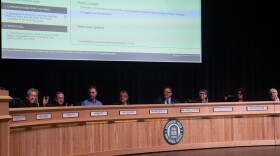CORPUS CHRISTI, Texas -- The Department of Homeland Security has taken to the high skies for its latest high-tech border security program.
It has retooled the unmanned aerial vehicle, commonly known as a drone, an established military weapon. The drone has been turned into a new civilian, eyes-in-the-sky border protection instrument.
The program is operated by the Office of Air and Marine, a division of U.S. Customs and Border Protection, the agency within the Homeland Security Department responsible for securing the nation's borders.
Michael Kostelnik, a former Air Force Major General, is in charge of Air and Marine.
"Today we form the world's largest law enforcement air force," he said.
Kostelnik’s fleet has grown to 270 aircraft, including 10 drones with bases at the U.S-Mexico border in Arizona and here in Corpus Christi, on the Texas Gulf Coast about 150 miles southeast of San Antonio.
There's another operations center in South Florida and the northern border base is in North Dakota.
The border drones are Predator B models. They've been modified from the standard military-issue types, which are armed with weapons and are being currently used in the war in Afghanistan and in certain strikes in Pakistan.
Instead of missiles, the civilian-styled border drones, which cost $18 million apiece, carry powerful radars. They look like high-tech gliders without cockpits.
In an interview, Kostelnik didn't stop raving about the ability the drones have to scan large swaths of land from 20,000 feet up in the air while still being able to zoom in so close that footprints can be seen on the ground.
The drones are credited with leading to the arrests of more than 62,000 illegal immigrants, nearly 2,000 smugglers and more than 800,000 pounds of drugs, all in 2010, the latest available count.
The Corpus Christi operations center is on the second floor of an airplane hangar inside the Naval Air Station. Two to three agents at a time rotate shifts, their eyes constantly staring at various flat-screen monitors on the wall -- indicating the drone's flight path, the live images relayed from up above and Google Earth maps to corroborate "hot spots," or known locations along the 350-mile Texas coastline and 1,250-mile Texas-Mexico border known for illegal activity.
"Alright guys, we're done with the test, let's go on the mission profile," one of the agents spoke into the radio to the drone pilot and co-pilot. The pilots are actually based outside in a trailer because this naval base site was not originally set up to have a full-fledged drone operations center.
The pilot and co-pilot, technically called the sensor operator, work out of flight stations inside the trailer. They sit in pilot chairs and have their own screens to monitor -- seeing the same relayed drone images as their counterparts in the operations center next door. The pilot operates the drone through a joystick.
Homeland Security requested that the agents remain unidentified, for their safety.
"Alright, if you want to step out and scan down to the river for a while, our next target is 20 miles away," the dispatch agent instructed the pilot after the drone flew along the Texas coast and made a sharp western turn to scan the Rio Grande.
Suddenly, the pilot spotted something suspicious. Several people on the Mexican side of the Rio Grande jumped in the water.
"There’s something over there, I just saw something move across the road there," the pilot said.
It makes Border Patrol administrator Hector Black perk up. Adapting to the increased use of drones as part of its work, the Border Patrol recently assigned a full-time staffer to the operations center to act as a liaison between the center, the flight station and the agents on the ground.
The pilot seeing unusual activity was case in point.
While on the ground it would have been harder and would have taken more time to decipher what was going on, the drone images revealed fairly quickly that the potential drug smugglers or illegal immigrants were actually Mexican fishermen cooling off in the Rio Grande.
And the intelligence sharing works both ways. Black gets a call from his colleagues out of the McAllen Border Patrol station, saying they were tipped to a potential smuggling attempt further down river. Immediately, Black relayed the information to drone agents sitting next to him, who in turn coordinated with the pilot to check out the site.
Most of the time the work can get mundane if there's not a lot going on. But Tom Mason likes the fact that at any moment, the monotony could be broken with a big case.
"This is a really fun job," said Mason, who used to fly for the Navy. "Some of the missions, some of the things you get to do, some of the chases, some of the things you get to see. You get to take down either a boat or an airplane with a bunch of stuff in it."
Yet despite its tremendous growth, the drone program may be going into a holding pattern. A Homeland Security Inspector General report in May cited it for poor planning and oversight. Drones could be flying more than 10,000 hours a year, the report says, but so far they’ve been put to use for only 4,000.
The agency said bad weather often plays a role, not allowing the drones to take off or forcing them to land sooner than expected. But the report said overall the program has been successful and will keep improving through growing pains.









